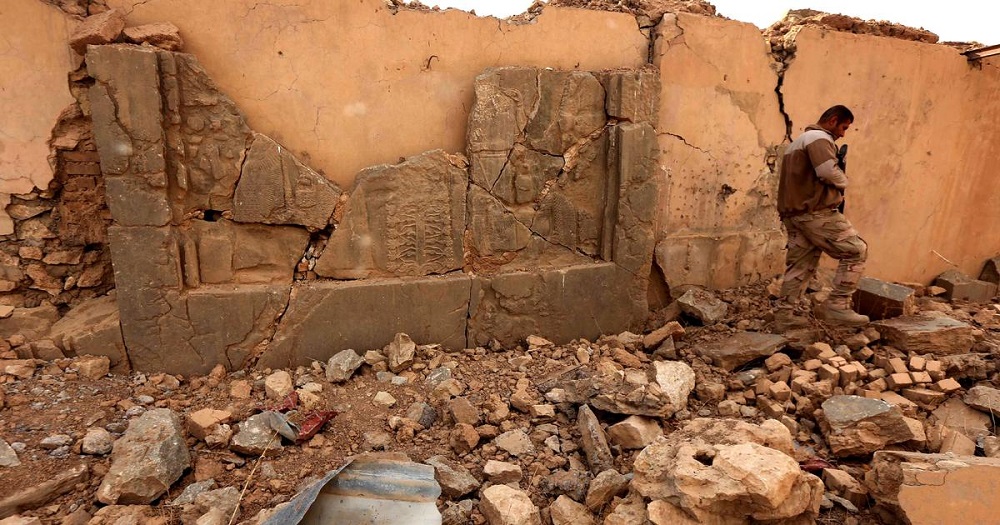Agatha Christie lived here once, but only memories remain of the time the best-selling crime writer spent among the ruins of the ancient Iraqi city of Nimrud.
The mud-brick house where the British author of “Murder on the Orient Express” once stayed is long gone. If she were alive today, she would probably be shocked by what has befallen the Assyrian city where she worked alongside her archaeologist husband five decades ago, said a Reuters reported on Friday.
ISIS terrorists attacked Nimrud with bulldozers, jackhammers and dynamite three years ago as part of their general assault on Iraq’s cultural heritage.
Iraqi military forces retook the site early in their campaign to drive the extremists out of Mosul, which lies about 30 km (20 miles) north.
The house where Christie lived on site was knocked down some years before that, and the people who knew her have all died. But her name still stirs recognition among locals, although most do not know what she is famous for.
“We just know that she was British,” said Abu Ammar, who lives in the closest village to the ruins.
Famed for her detectives – Miss Marple and Hercule Poirot – Christie is listed by Guinness World Records as the best-selling fiction author of all time. Her 78 crime novels have sold 2 billion copies in 44 languages.
Christie first visited Iraq before it gained independence from Britain in 1932 and met the man she would marry on an archaeological dig in the south.
The couple spent time in Mosul, and eventually moved to Nimrud.
“What a beautiful spot it was,” she wrote. “The Tigris was just a mile away, and on the great mound of the Acropolis, big stone Assyrian heads poked out of the soil. It was a spectacular stretch of country – peaceful, romantic and impregnated with the past.”
That description stands in contrast to the present.
The mound on which the ruins are situated has a fresh crown of razor wire to keep looters out, and until recently, corpses floated down the river Tigris from battlefields upstream.
Colossal winged bull statues – or lamassus – that stood guard at the entrance to a palace lie dismembered in a heap.
“Look, there’s a foot,” said Iraqi army Captain Ali Adnan, pointing out a giant talon carved from a slab of stone. Feathers and cuneiform letters are chiseled into other fragments.
Much of it was unearthed during the 1950s by Christie’s husband, Max Mallowan, who wrote the book: “Nimrud and its Remains”.
Christie’s own interest in archaeology is evident in “Death on the Nile” and “Murder in Mesopotamia” and she began writing her autobiography in Nimrud.
But she spent most of her time there documenting Mallowan’s work in photographs, and cleaning ivories dug up from the ruins, using her own face cream to coax dirt out of the crevices, said Reuters.
Mohammed Saeed is too young to have met Christie, but he is familiar with her legend.
A local man, he has worked on excavations at Nimrud since 1996, and used to show tourists around in less turbulent times.
“Here was Agatha Christie’s room,” he said, standing on a nondescript patch of scorched ground at the edge of the mound. “Now nothing is left.”
Saeed was present when ISIS took over and remained as a guard at the site until he started receiving threats from the extremists.
Over the following months, he saw bulldozers at work on the mound, and at night, cars came and went. He suspected they were traders inspecting what could be sold to fill ISIS’ coffers. A year later, the extremists blew up the site.
“I can’t describe how I felt. My brothers thought I was going to die,” said Saeed. “The ruins are a symbol — a civilization. They represent this nation.”
It is a feeling he believes Christie would have shared: “She probably would have collapsed,” he said.
There is hope however. Saeed said there were plans to begin excavating the southern palace next spring.
As Christie prepared to leave Nimrud, she wrote:
“Now Nimrud sleeps. We have scarred it with our bulldozers. Its yawning pits have been filled in with raw earth. One day its wounds will have healed, and it will bloom once again with early spring flowers … Who shall disturb it next? We do not know.”
